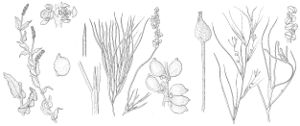Difference between revisions of "Ruppiaceae"
FNA>Volume Importer |
FNA>Volume Importer |
||
| Line 43: | Line 43: | ||
|publication year= | |publication year= | ||
|special status= | |special status= | ||
| − | |source xml=https://jpend@bitbucket.org/aafc-mbb/fna-data-curation.git/src/ | + | |source xml=https://jpend@bitbucket.org/aafc-mbb/fna-data-curation.git/src/8f726806613d60c220dc4493de13607dd3150896/coarse_grained_fna_xml/V22/V22_334.xml |
}}<!-- | }}<!-- | ||
-->[[Category:Treatment]] | -->[[Category:Treatment]] | ||
Revision as of 15:57, 18 September 2019
Herbs, annual or rarely perennial, not rhizomatous, caulescent; turions absent [present]. Leaves alternate to subopposite, submersed, sessile; sheath not persisting longer than blade, not leaving circular scar when shed, not ligulate, not auriculate; blade linear; intravaginal squamules scales, 2. Inflorescences terminal, capitate spikes, with subtending spathe, pedunculate; peduncle following fertilization often elongating, often spiraling. Flowers bisexual; subtending bracts absent; perianth absent; stamens 2, in 1 series; anthers distinct, dehiscing longitudinally; pollen arcuate; pistils 4–16, distinct, stipitate; ovules parietal, campylotropous. Fruits drupaceous. Seeds 1; embryo straight.
Distribution
Nearly worldwide.
Discussion
Ruppiaceae are found submersed in brackish or saline waters or fresh waters with very high calcium or sulfur ion concentrations.
Genus Genera 1, species ca. 10 (2 species in the flora).
